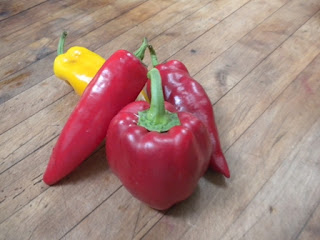 |
| Busy bees |
Greetings from the Garden! This box has arugula and kale, tomatoes, eggplant, cucumbers, kohlrabi, celery, basil, golden beets, and leeks.
 |
| Covered Annual flowers |
Field Notes. Although frost was forecast for Monday night, we were not that cold - only 34 degrees. I had taken the precaution of covering some annual flowers, and picked today's basil. Ken is getting ready to harvest the winter squash, so I will be shifting the onions from drying racks to storage bins.
This weather reminds us that there is still much to harvest - potatoes, root crops like beets, carrots, celeriac, black and daikon radishes, rutabagas. These will go to the root cellar for fall and winter boxes. The greenhouses will extend the season for many crops. That adds variety to the boxes.
Ken and Loyal have been cutting trees and brush to get ready for the heavy equipment that is coming to finish the irrigation pond by the mobile high tunnel, and the dam and irrigation pond for the garden. These collection areas for water will enable us to better cope with heavy rains when we get them, and save water for irrigation when we have extended dry periods during the growing season. Ken has read that we are in a no rain shadow created by the Twin Cities, and this is one explanation for our lack of rain this growing season - even when the cities got rain and it appeared to be headed our way.
From the Kitchen. Many farms end their season in October, but years ago when members requested we extend the season so they did not have to go to the store, we did. We eat our produce all year - some is stored, some is cultured, some was frozen during peak season. Our diet varies with the seasons. As it gets colder I light the oven more often, start roasting meat and vegetables, make hearty stews, and other heavier, calorie dense food. Today I am stewing meat and vegetables for midday meal.
This crop of kohlrabi is mostly tops. These greens are like cabbage or kale. Great in soup, stir fry or a wilted salad.
 The golden beets are a real treat. Many people say they do not like red beets, but like the golden ones. They have a lighter, less earthy flavor and are a bit sweeter. I use them in any of my beet recipes. Unlike red beets, they will not turn the dish pink.
The golden beets are a real treat. Many people say they do not like red beets, but like the golden ones. They have a lighter, less earthy flavor and are a bit sweeter. I use them in any of my beet recipes. Unlike red beets, they will not turn the dish pink.
Ah, leeks. Leeks start in late summer and early fall and are one of my favorites. They are the creamiest of the onions. I love their mellow onion flavor in soups and stews. To clean a leek, cut it lengthwise and rinse out any soil between layers. I use the white portion in quick cooking and the tops in stocks and long cooking as they are tougher.
And as a last summer recipe - here from our friend Dianne, is an eggplant recipe:
"As for your request for an eggplant
recipe, I made this last night but I don't have a written recipe. It's
yummy, fast and easy, and I make it often in the summer when it's too
hot to eat meat.
Slice
eggplant in 1/2 inch slices. Dip in beaten egg with a tablespoon of
cold water. Then coat in Italian style bread crumbs. Fry in a little
olive oil till brown. Put in shallow baking dish and top with slices of
tomato. Sprinkle grated mozarella and parmesan over all. Bake in 400
degree oven for 15 min. or till slightly brown on top. It's good with pasta flavored with a little salt, pepper, butter and Parmesan."
'Til Next Week,
Judith













































